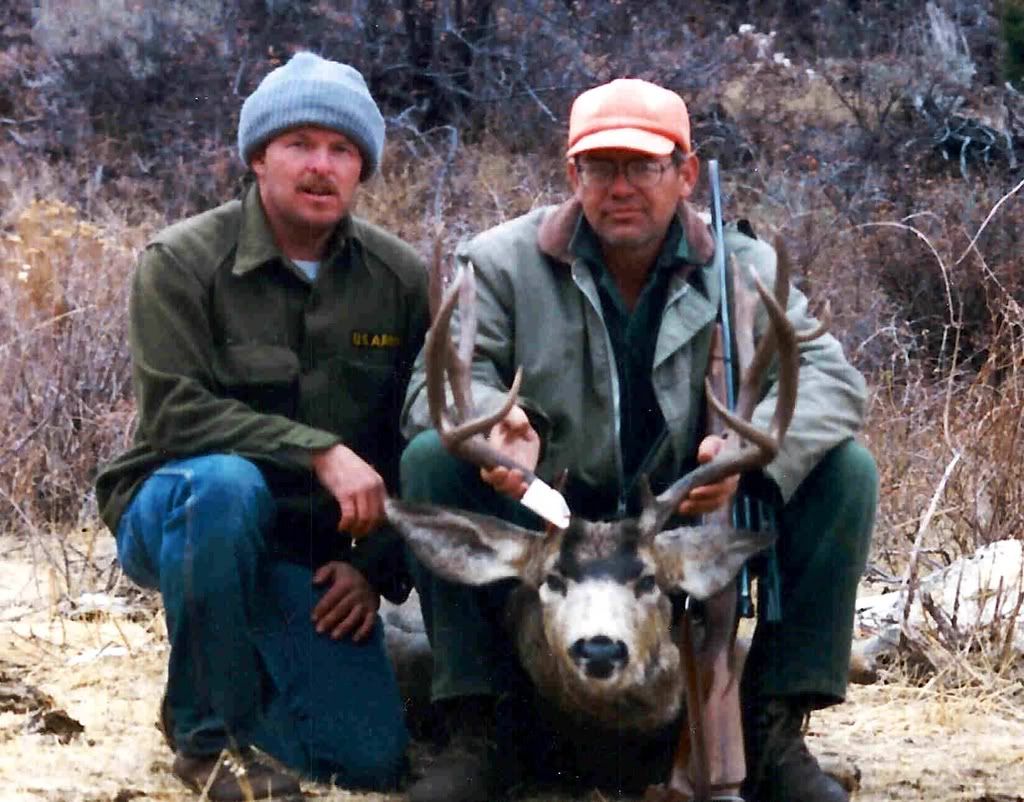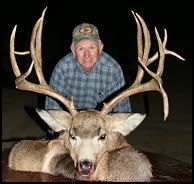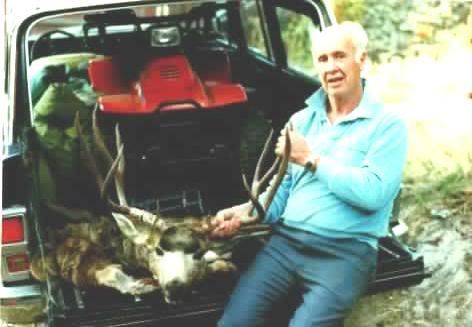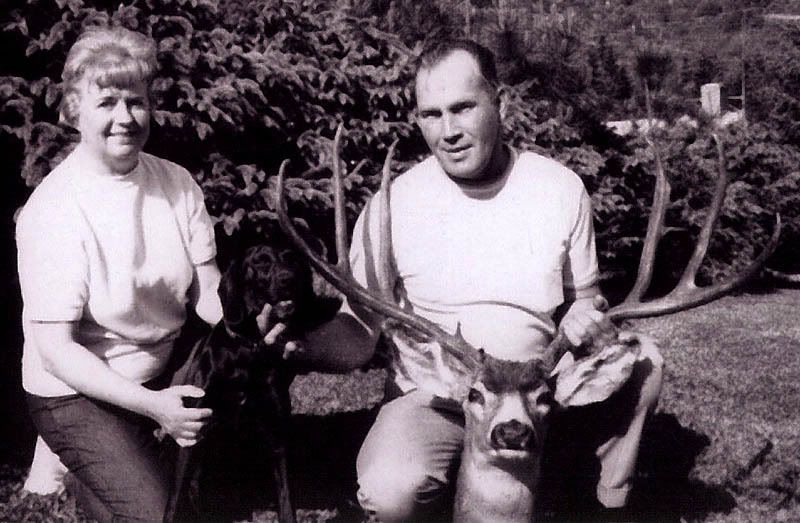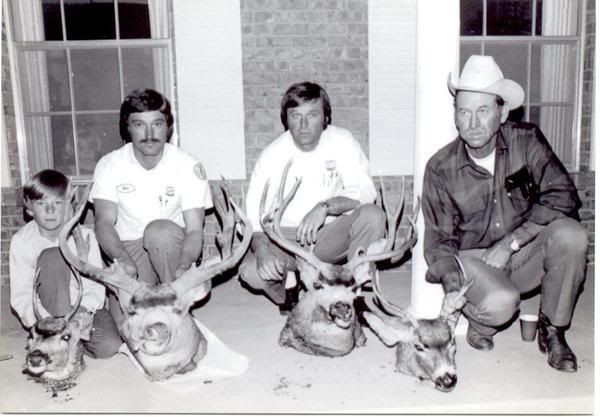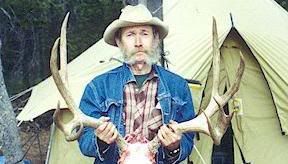Bruce Stillings, big game biologist, Dickinson, said biologists counted 2,649 mule deer in 291 square miles. Mule deer density per square mile was 9.1, a slight decrease from 9.6 in 2007, but significantly higher than the long-term average of 6.6 mule deer per square mile.
Biologists have completed aerial surveys of the same 24 study areas since the 1950s. The survey assists the department in obtaining solid mule deer population data for the badlands, such as demographic trends and production ratios (buck-to-doe and fawn-to-doe).
Mild winters, good production, and a conservative and responsible harvest strategy have provided above-average mule deer density in the badlands.
—————————-
North Dakota’s 2008 deer season will offer 149,400 licenses to hunters this fall, an increase of 850 from last year. Mule deer licenses will increase in the Badlands because surveys showed a stable to increasing number of deer. The number of mule deer licenses available for 2008 is 8,600, an increase of 250 from last year.For muzzleloaders, 2,816 licenses, 12 more than last year, are available, and there will be 345 restricted youth antlered mule deer, up five from last year.The fall also will include a seven-day experimental antlerless-only season in northeastern North Dakota that will run from Sept. 26 to Oct. 2 only for hunters with 2C and 2D antlerless, or doe, deer licenses.
Mild winters and a corresponding increase in reproductive success helped white-tailed deer populations climb above management objectives in many units in northeastern, north-central and parts of southwestern North Dakota, said Randy Kreil, NDGFD wildlife chief.
“We will continue to be aggressive in units where deer numbers are above management goals,” Kreil said.
Units with deer numbers closer to management objectives are in the northwest and southeast.
Another consideration for the special season in the northeast is the bovine tuberculosis outbreak in neighboring northwestern Minnesota.
“We believe it would be prudent to reduce deer numbers in this area ahead of an unlikely but not improbable movement of this disease into North Dakota,” said Kreil.
The 2008 deer gun season opens at noon Nov. 7 and continues through Nov. 23. Online applications for the regular deer gun, youth and muzzleloader seasons are available through the NDGFD’s Web site, http://gf.nd.gov. Paper applications will be available at vendors throughout the state by mid-May. The deadline for applying is June 4.
Mule Deer Fanatic
Bringing the Mule Deer world together, one hunter at a time
Update on North Dakota Mule Deer Status
Why I hunt
I found this article about the reason for hunting and I liked it, but before passing it on, I would like to add a few comments of my own.
Hunting is often referred to as a sport. Detractors may froth at the mouth and call it a blood sport because they do not understand. I have often reasoned that all sports have one thing in common: They provide the participant with a rush-producing challenge. If not so, who would participate?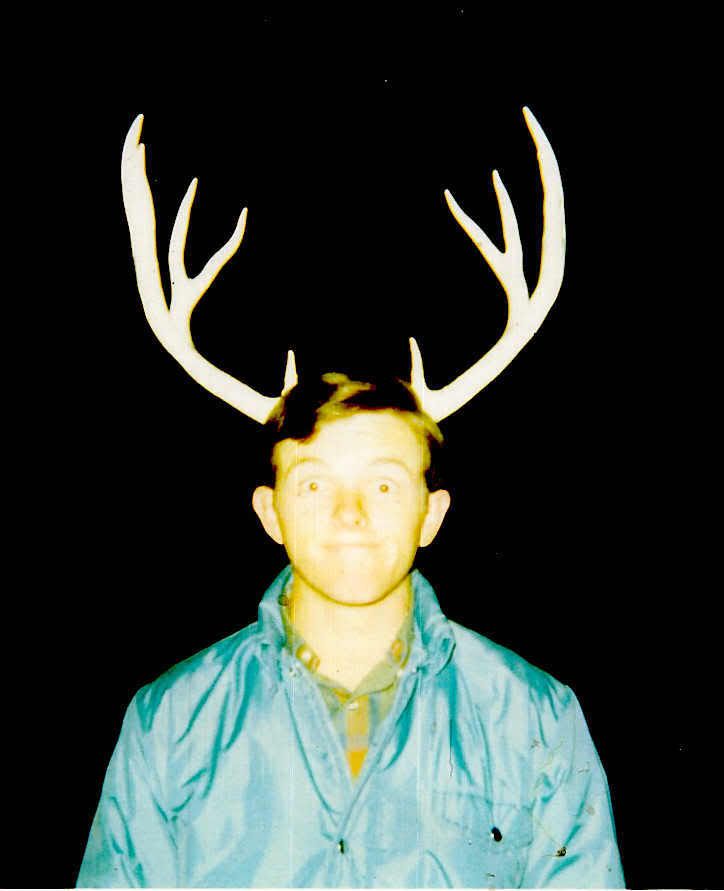
It is difficult, at best, for me to describe why I hunt, since the reason is so multi-faceted. Camaraderie, outdoors, challenge, wits, adrenaline, all come to mind and yet, this is still only the tip of the iceberg. Someday, I will invest the time to fully describe my enthusiasm for hunting. For now, suffice it to say – I still don’t completely understand it. I do know that I am a MULE DEER FANATIC.
—————————————–
This article appears in the deerPhD blog and was written by Bryan:
Ask any hunter about the ‘rush’ that occurs as a buck approaches, and he or she will undoubtedly tell you it’s like no other ‘high’ they’ve known. A primary cause of this rush is adrenalin, and it’s another reason why I hunt.
I definitely wouldn’t lump hunters into the category of “Thrill-seekers”. You know, people who jump off cliffs or out of planes, or stuff like that. Granted, I’ve done my share of thrill-seeking in my day: bungee jumping, jumping off of a 70 foot bridge into a river, etc. However, the adrenalin rush that occurs during a hunt is so much different. It’s coupled with peace and anticipation, and if I don’t experience the rush I won’t stop hunting. That is, I don’t hunt for the Adrenalin rush, but if it occurs (i.e., if I see a buck), it’s icing on the cake.
I mentioned before that many hunters will describe the hunting rush as being better than any other high. To illustrate this point, I want to share a story about a hunting guide I once met; his name was Fred. During our hunt, Fred shared his story with me. He talked about how he used to ride be a wild biker and a drug addict. Fred had experienced most ‘highs’ of this world. Fred added that as he started to straighten out his life, he missed the ‘highs’ of his old life…and then Fred discovered hunting. Here’s a quote from Fred as we finished tracking my first wild boar:
”(Loud holler). That’s it buddy! You did it! I get the shakes and I’m not even hunting right now…this is the best feeling in the world! You know, I’ve been drunk and high and everything in between, and I wouldn’t trade this feeling right now for any of that!”
I guess sometimes Adrenalin can be our worst nightmare too, such as when our shaking legs inhibit us from implementing a successful and ethical shot. But that’s one of the glories of hunting. You’ve got to master your prey and yourself to be good.
Here’s to the rush…and here’s to guys like Fred…
Update on Nevada Mule Deer Status

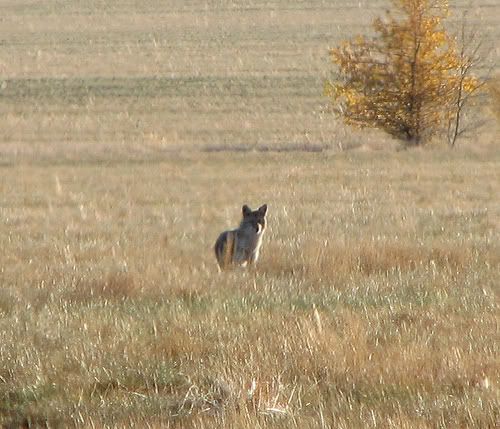 Nevada plans to reduce mule deer tag numbers for 2008 owing to very low fawn/doe ratios. This points to coyotes, but I doubt DOW personnel are willing to acknowledge it. I think they would rather blame the weather.
Nevada plans to reduce mule deer tag numbers for 2008 owing to very low fawn/doe ratios. This points to coyotes, but I doubt DOW personnel are willing to acknowledge it. I think they would rather blame the weather.
——————————————-
In 2007, there were 18,261 deer tags available to resident and nonresident hunters. If the commission chooses to adopt recommendations from NDOW wildlife biologists there will be 16,242 deer tags available in 2008, a reduction of 2,019 tags. This reduction follows back-to-back deer surveys in which biologists documented very low fawn production.
During fall deer surveys we “classified more than 19,000 deer but documented one of the lowest fawn production values ever observed at 33 fawns per 100 adults. Spring surveys found the statewide average fawn-to-adult ratio to be just 26 fawns to 100 adults. Especially hard hit were the northeast, central and east-central portions of the state,” said Mike Dobel, NDOW supervising game biologist in Reno.
The habitat conditions leading to low fawn production and survival rates this past year are similar to those that lead to low fawn recruitment (birth & survival rate) following the winter of 1992-93. In that circumstance, Dobel said, a drought period was followed by a heavy winter. Likewise, the winter of 2006-07 was very dry but the winter of 2007-08 had average to above average precipitation combined with extremely cold temperatures.
Statewide the estimated mule deer population is 108,000, a five percent decrease from the 2007 estimate. The 2008 tag quota recommendations are available on the NDOW website – www.ndow.org.
Do Antler Point Restrictions work?
Whether antler point restrictions work or not depends on what you think the objective is. If the objective is for hunters to see more mature bucks while hunting, then it works. If the objective is to increase buck harvest or to improve herd genetics, then maybe it doesn’t.
A story from Michigan:
Beginning in 1993 with the “Dooly County Experiment” in Georgia, several counties and deer management units (DMUs) across the U.S. have been placed under state-regulated antler restrictions.
Today, numerous counties or DMUs in Georgia, Michigan, Louisiana, Texas, New Jersey, and other states are operating under some form of minimum antler restriction. These are in addition to statewide antler restrictions in Mississippi, Arkansas, and Pennsylvania. Collectively, these restrictions have resulted from the growing support among sportsmen for opportunities to manage and hunt whitetails under the Quality Deer Management (QDM) approach.
The notoriety of the Dooly County project spurred the interest of Michigan schoolteacher and avid whitetail hunter, Marc Yenkel of Claire, Michigan. In 1996, Marc petitioned the Executive Director of the Michigan Department of Natural Resources (MIDNR) for an antler restriction in his immediate hunting area of about three square miles. It was politely refused.
“We wanted a chance to harvest 2 1/2- or 3 1/2-year-old bucks,” said Marc. “People around here had bushel baskets of 4-point racks. We wanted the opportunity, the challenge of hunting an older deer. I have 160 acres and the guy next to me has 3,000 and it really snowballed from there.”
Despite the failed first effort, Marc gathered several local supporters and petitioned the Michigan Natural Resources Commission (MNRC) in 1997 for a larger area of about 20 square miles. This also was rejected on the basis that it would break-up an existing DMU. Marc then joined the Mid-Michigan Branch of the Quality Deer Management Association (QDMA) and together they drafted a proposal for all of DMU 118 (173,000 acres) with input from the MIDNR Wildlife Division.
Based on this request, the MIDNR adopted guidelines similar to those used in Georgia, which require, among other things, landowner and hunter surveys to be conducted in the affected area to gauge support. A minimum of 66 percent support from both landowners and hunters is then required for the antler restriction to be implemented. Eventually, a survey was conducted, which revealed 68 percent support from landowners and 53 percent support from hunters for a mandatory 3-points-on-one-side minimum antler restriction in DMU 118. The MIDNR withdrew their support due to the hunter survey not meeting the 66 percent minimum support requirement. Still undeterred, Marc and his supporters petitioned the MINRC again in 1999 and were successful in obtaining the necessary 4-vote majority within the Commission to proceed with the regulation for a minimum of five years.
Unlike most other county-wide antler restrictions, DMU 118 provides a unique opportunity to objectively assess the potential of this approach because deer harvest data have been regularly collected for many years, both pre- and post-implementation of the restrictions. Now, four years into the 5-year program, the results have been very encouraging. The following results were prepared from data provided by the MIDNR. Results
– total deer harvest in DMU 118 peaked in 1999 (the year following implementation of the antler restriction) at 416 deer and appears to be stabilizing around 250 animals, or slightly above the 3-year base average of 235 before the initiative began.
Importantly, the sex ratio within the harvest has improved considerably. Prior to introduction of the antler restriction, an average of 1.9 bucks were harvested for every doe harvested. The 4-year average during this initiative was 1.3 bucks harvested per doe (range 1.1-1.7). Also, the total antlerless harvest exceeded the 3-year base average of 104 during each of the four years, including 2002 when 109 antlerless deer were harvested. The steady decline in antlerless harvest during the four years of this initiative is likely due to a reduction in total deer density as reported by many hunters in the area.
One of the most encouraging results was that, contrary to many predictions, total buck harvest did not decline under this restriction. In fact, in all four years, except 2001, total buck harvest exceeded the 3-year base average of 131 (range 117-203).
Another positive result was the decline in the percentage of button bucks in the antlerless harvest (Figure 2). The 3-year base average prior to the restriction was 19 percent, compared to the 4-year average during the project of 11.5 percent — a 39 percent reduction. It is likely that the increased survival of button bucks was a major reason why total buck harvest remained above the 3-year base average when the total herd was being reduced through increased antlerless harvest.
The impact of the restriction on the ages of bucks in the harvest also was encouraging (Figure 3). Following a slight increase in the number of yearling bucks harvested in 1999, this number has declined to around 60 — a 41 percent reduction from the 3-year base average of 102. This decrease occurred despite the fact that the 3-points-on-one-side restriction only protects around 50 percent of the yearling bucks in this area.
As expected, the protection of yearling bucks resulted in an increased harvest of older bucks. For example, the 3-year base averages for 2 1/2-, 3 1/2-, and 4 1/2+-year-old bucks were 21, seven, and one percent, respectively. In contrast, the 4-year averages for these age classes following the restriction were 49, 23, and four percent, respectively. This translates to increases of 133 percent, 229 percent, and 300 percent for 2 1/2, 3 1/2, and 4 1/2+ year olds, respectively.
While the data show a drastic improvement, the regulations were a hit with many hunters in the area.
“It only took about two years to see the results and it just keeps getting better,” Marc said. “This year I took a buck that grossed 107 inches and my son took a buck 97 inches, and they were heavy deer. The buck to doe ratio has improved drastically.”Discussion
The results from this study provide strong evidence that state-regulated antler restrictions can produce positive outcomes in whitetail herds, and in a relatively short period of time. At least in this example, it appears that the three primary objectives of this antler restriction — increased antlerless harvest, decreased button buck harvest, and increased harvest of older bucks — are being achieved. The increased antlerless harvest has apparently reduced deer density, which provides obvious benefits to landowners and agricultural producers. The decreased button buck harvest demonstrates that hunter education and commitment to a QDM-type program are determining factors to hunter selectivity. The increased number of older bucks has resulted in a more balanced adult sex ratio and an increased number of older, larger-antlered bucks available for harvest. The increased presence of older bucks also increases the intensity of rutting activities and provides opportunities for hunters to incorporate rattling and calling techniques into their hunting strategies.
Despite the obvious success of this initiative, a recent survey by the MIDNR revealed that landowner and hunter support for continuation of the restriction is still below 66 percent. It remains unclear if the MIDNR will continue the restriction beyond the 2003 hunting season, the end of the initial 5-year period. Regardless, the results of this study reveal that the combination of proper doe harvest and protection of yearling bucks can produce positive outcomes for deer herds, deer habitats, and deer hunters.
It’s time to Apply for your Oregon Deer Tag

Oregon does not have online applications yet and the deadline for applying is May 15, so get your Mule Deer tag application in the mail. You must purchase a license before applying. Oregon is also implementing mandatory reporting this year. Go HERE for more information.
Idaho Deer Tag Applications

It’s time to apply, if you want to hunt mule deer in Idaho. Idaho has been over-priced since the early 90’s, and in spite of a “mule deer recovery” plan, there still aren’t many more mule deer in the great Gem state. From May 1 to June 5, you can apply for an Idaho deer tag.
For more info click IDAHO HUNT INFO
Global Warming to kill Mule Deer

Below is an article posted in the Washington Press where hunting and fishing organizations are referred to as swing groups, where there seems to be a race by sportsmen’s organizations to be politically correct, and where mule deer are expected to disappear from the Western US.
I’m afraid that Mule Deer have a lot more to worry about than global warming ( how many Mule Deer have disappeared because of lions and coyotes? ) Check out the article below, then click on this link to see how much you know about Global Warming.
Hunters, anglers worry about global warming, loss of wildlife
WASHINGTON (AP):
————————————–
Global warming could force elk and mule deer from much of the western United States. Wild trout could disappear in lower Appalachian streams. Two-thirds of America’s ducks may disappear.
A new U.S. assessment of the threat to fish and wildlife habitat has hunters and anglers calling for action.
Groups representing nine major hunting and fishing organizations planned to meet Thursday with the House committee chairman who hopes to write legislation to curtail greenhouse gases linked to global warming.
“These are the branches of the conservation movement from which I come,” Democratic Rep. John Dingell said in an interview with The Associated Press. Dingell said the groups’ concerns are very important in helping with a measure to address the problem.
Dingell is an avid sportsman whose office is adorned with hunting and fishing trophies. As the leader of the House Energy and Commerce Committee, he has promised action on climate change. He also has issued a series of reports examining legislation that would cap carbon dioxide _ a product of burning fossil fuels _ and other greenhouse gases. The Senate is considering similar legislation.
The alarm sounded by hunting and fishing organizations is significant.
They “are a critical swing constituency in so many states,” said Paul Bledsoe, a spokesman for the National Commission on Energy Policy. The bipartisan group argues for mandatory steps to reduce climate change pollution.
Alan Wentz of Ducks Unlimited Inc., one of the groups meeting with Dingell, noted that scientists are predicting that climate change “will significantly affect almost every aspect of our environment, including North America’s wetlands and waterfowl.”
The others are Trout Unlimited, Pheasants Forever, BAAS/ESPN Outdoors, Izaak Walton League of America, Association of Fish and Wildlife Agencies, the Coastal Conservation Association, the American Sportsfishing Association, Pheasants Forever and the Wildlife Management Institute, a Washington-based advocacy group for hunters and sportsmen.
“Sportsmen are seeing the effects of climate change and know full well that foresight and proactive management will be necessary to help fish and wildlife adapt,” said George Cooper, president of the Theodore Roosevelt Conservation Partnership.
A report compiled by the Wildlife Management Institute and based on work done by the groups provided a glimpse of their concerns. It says:
_Prairie pothole regions essential for waterfowl could lose 90 percent of their wetlands, causing a 69 percent decline in North America’s breeding ducks.
_About 42 percent of the trout and salmon habitat could be lost by the end of the century, with bull trout virtually disappearing in the high mountain West and wild trout from lower Appalachian streams.
_The number of Pronghorn antelope, elk and mule deer will dwindle as rising temperatures allow trees and shrubs to overwhelm the sagebrush ecosystem in the West.
_Populations of bobwhite quail will shrink in the Deep South as summertime drought and higher temperatures disrupt their breeding cycles. And drier conditions in fall and early spring will threaten quail in the Southwest.
_While an increase in water temperature and other change could benefit some salt water marine species, sea-level rise would destroy thousands of acres of coastal salt marshes and seagrass that are home to larval and juvenile game fish.
“We know now that climate change has the very real potential to affect fish and wildlife resources and activities that hunters and angers hold dear … and on a landscape level scale that is incomparable in modern times,” warned Matt Hogan, executive director of the Association of Fish and Wildlife Agencies.
Cows help Reseeding Project
Friday, April 11, 2008 Salt Lake City
Planes aid in success of reseeding program
Published: Thursday, April 10, 2008 12:08 a.m. MDT
——————————————
Last year, wildlife biologists used an old-fashioned but innovative approach to restoring habitat for mule deer and other wildlife at the Hardware Ranch Wildlife Management Area by teaming cattle with airplanes.
Two seasons of intensive grazing by cattle had removed much of the cheatgrass on the south-facing slopes of Blacksmith Fork Canyon. Conditions were ideal for reseeding the area with plants that are perfect for the wildlife.
The reseeding effort was part of a long-range Division of Wildlife Resources’ plan to restore critical big game winter habitats at Hardware Ranch, which is 15 miles east of Hyrum.
Park of the plan involved airplanes dropping nearly $30,000 worth of seed on the ground.
The seed mixture the planes dropped was a special blend of forbs and shrubs. The plants are designed to give wildlife the nutrition and energy they need to survive harsh winters. These plants are also designed to help wildlife transition from their winter diet to spring and summer diets.
Because of the terrain, using heavy equipment to resort hillsides was impossible.
Instead, livestock were put into the area to graze. This was followed up by reseeding the mountainside by airplane.
Utah Wildfires – 2007

Utah’s 805 wildland fires have scorched more than 689,495 acres as of Aug. 6, according to the Boise, Idaho-based National Interagency Fire Center.
In an attempt to help Mother Nature rehabilitate the landscape wildlife depend on for food, shelter and protection, local, state and federal officials will plow charred soils and begin reseeding the area by hand and aircraft.
The Bureau of Land Management requested $30 million in seed to help rehabilitate federal property damaged by the Milford Flat fire. State officials will spend about $3 million on reseeding efforts, said Tyler Thompson, a statewide habitat conservation coordinator for DWR. “The challenge will be getting enough seed,” he said. “The next biggest hurdle is going to be the vast size of the burned area, and getting that seed on the ground.”
When crews begin seeding this fall, they will use a chemical called “Plateau” to target the highly flammable cheatgrass, an invasive species that fuels wildfires.
Habitat charred by big wildfires
* Milford Flat: More than 363,052 acres
* Salt Creek: 25,456 acres
* Neola North: More than 44,000 acres
By Nathan C. Gonzalez

